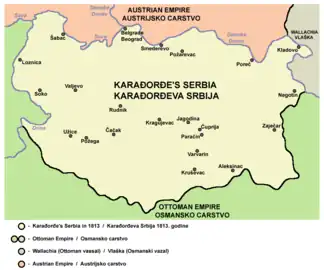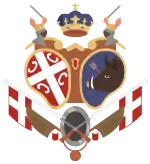Revolutionary Serbia Устаничка Србија Ustanička Srbija | |||||||||||
|---|---|---|---|---|---|---|---|---|---|---|---|
| 1804–1813 | |||||||||||
.svg.png.webp) Revolutionary Serbia within Europe, 1812 | |||||||||||
| Status | Self-proclaimed rebel sovereign state | ||||||||||
| Capital | |||||||||||
| Official languages | Serbian | ||||||||||
| Religion | Serbian Orthodoxy (official) | ||||||||||
| Demonym(s) | Serbian, Serb | ||||||||||
| Government | Not specified1 | ||||||||||
| Grand Vožd | |||||||||||
• 1804–1813 | Karađorđe | ||||||||||
| President of the Governing Council | |||||||||||
• 1805–1807 | Matija Nenadović | ||||||||||
• 1811–1813 | Karađorđe | ||||||||||
| History | |||||||||||
• Established | 1804 | ||||||||||
| 1804–1813 | |||||||||||
| July 1806–January 1807 | |||||||||||
| 10 July 1807 | |||||||||||
• Restoration of Ottoman rule | October 1813 | ||||||||||
• Disestablished | 1813 | ||||||||||
| Area | |||||||||||
| 1815[1] | 24,440 km2 (9,440 sq mi) | ||||||||||
| Population | |||||||||||
• 1815[1] | 332,000 | ||||||||||
| ISO 3166 code | RS | ||||||||||
| |||||||||||
^1 Possibly a hereditary monarchy, at least from 1811, when the People's Governing Council, soon after its establishment, recognized Karađorđe as Serbia's hereditary leader and pledged allegiance to his "lawful heirs".[2] | |||||||||||
Revolutionary Serbia (Serbian: Устаничка Србија / Ustanička Srbija), or Karađorđe's Serbia (Serbian: Карађорђева Србија / Karađorđeva Srbija), refers to the state established by the Serbian revolutionaries in Ottoman Serbia (Sanjak of Smederevo) after the start of the First Serbian Uprising against the Ottoman Empire in 1804. The Sublime Porte first officially recognized the state as autonomous in January 1807, however, the Serbian revolutionaries rejected the treaty and continued fighting the Ottomans until 1813. Although the first uprising was crushed, it was followed by the Second Serbian Uprising in 1815, which resulted in the creation of the Principality of Serbia, as it gained semi-independence from the Ottoman Empire in 1817.
Political history
First Serbian Uprising
Stratimirović's Memorandum
- Stratimirović's Memorandum (1804)[3]
Ičko's Peace
Between July and October 1806 Petar Ičko, an Ottoman dragoman (translator-diplomat) and representative of the Serbian rebels, negotiated a peace treaty known in historiography as "Ičko's Peace". Ičko had been sent to Constantinople twice in the latter half of 1806 to negotiate peace. The Ottomans seemed ready to grant Serbia autonomy following rebel victories in 1805 and 1806, also pressured by the Russian Empire, which had taken Moldavia and Wallachia; they agreed to a sort of autonomy and clearer stipulation of taxes in January 1807, by which time the rebels had already taken Belgrade. The rebels rejected the treaty and sought Russian aid to their independence, while the Ottomans had declared war on Russia in December 1806. A Russo-Serbian alliance treaty was signed on 10 June 1807.
Russo-Serbian Alliance
On 10 July 1807, the Serbian rebels under Karađorđe signed an alliance with the Russian Empire during the First Serbian Uprising. After the Ottoman Empire had allied itself with Napoleon's France in late 1806, and was subsequently at war with Russia and Britain, it sought to meet the demands of the Serbian rebels. At the same time, the Russians offered the Serbs aid and cooperation. The Serbs chose alliance with the Russians over autonomy under the Ottomans (as set by the "Ičko's Peace"). Karađorđe was to receive arms, and military and medical missions, which proved to be a turning point in the Serbian Revolution.
Proclamations
- A proclamation (Slavonic-Serbian: Проглашенie) calling for the unity of Serbs, dated 21 February 1809.[4]
- A proclamation with 15 points, dated 16 August 1809.[5]
Treaty of Bucharest (1812)
Government


Rule was divided between Grand Vožd Karađorđe, the Narodna Skupština (People's Assembly) and the Praviteljstvujušči Sovjet (Governing Council), established in 1805.
Governing Council
The Governing Council was established by recommendation of the Russian Minister of Foreign Affairs Czartoryski and on the proposal of some of the voivodes (Jakov and Matija Nenadović, Milan Obrenović, Sima Marković).[6] The idea of Boža Grujović, the first secretary, and Matija Nenadović, the first president, was that the council would become the government of the new Serbian state.[7] It had to organize and supervise the administration, the economy, army supply, order and peace, judiciary, and foreign policy.[7]
| Date | Members |
|---|---|
| August 1805 | Mladen Milovanović, Avram Lukić, Jovan Protić, Pavle Popović, Velisav Stanojlović, Janko Đurđević, Đurica Stočić, Milisav Ilijić, Ilija Marković, Vasilije Radojičić (Popović, Jović), Milutin Vasić, Jevto Savić-Čotrić, Dositej Obradović and Petar Novaković Čardaklija |
| End of 1805 | Archpriest Matija Nenadović (president), and members Jakov Nenadović, Janko Katić, Milenko Stojković, Luka Lazarević and Milan Obrenović. |
| November 1810 | Jakov Nenadović (president), and members Pavle Popović, Velisav Perić, Vasilije Jović (Radojičić), Janko Đurđević, Dositej Obradović, Ilija Marković, and secretaries Stevan Filipović and Mihailo Grujović. |
Ministries
In 1811, the government system was reorganized, with the formation of ministries (popečiteljstva) instead of nahija-representatives.
| Ministries | Ministers |
|---|---|
| President | Karađorđe (s. –1813) |
| International Affairs | Milenko Stojković (s. 1811); Miljko Radonić (s. 1811–12) |
| Education | Dositej Obradović (s. 1811); Ivan Jugović (s. 1811–12) |
| Military | Mladen Milovanović (s. 1811–13) |
| Internal Affairs | Jakov Nenadović (s. 1811–13) |
| Law | Petar Dobrnjac (s. 1811); Ilija Marković (s. 1811–13) |
| Finance | Sima Marković (s. 1811–13) |
| Secretaries | Mihailo Grujović (1st) and Stevan Filipović (2nd) |
Maps
- Territory of Revolutionary Serbia
 In 1809
In 1809 In 1813
In 1813
See also
References
- 1 2 Michael R. Palairet (2002). The Balkan Economies c. 1800-1914: Evolution Without Development. Cambridge University Press. pp. 16–. ISBN 978-0-521-52256-4.
- ↑ Singleton 1985, p. 80.
- ↑ Vladislav B. Sotirović. ""The Memorandum (1804) by the Karlovci Metropolitan Stevan Stratimirović", Serbian Studies: Journal of the North American Society for Serbian Studies, Vol. 24, 2010, № 1−2, ISSN 0742-3330, 2012, Slavica Publishers, Indiana University, Bloomington, USA, pp. 27−48".
- ↑ Vjesnik Kr. državnog arkiva u Zagrebu. Vol. 17–18. Tisak zaklade tiskare narodnih novina. 1915. p. 124.
- ↑ Trifunovska 1994, pp. 3–4.
- ↑ Janković 1955, p. 18.
- 1 2 Čubrilović 1982, p. 65.
Sources
- Ćirković, Sima (2004). The Serbs. Malden: Blackwell Publishing. ISBN 9781405142915.
- Ćorović, Vladimir (2001) [1997]. Историја српског народа (in Serbian). Belgrade: Јанус.
- Čubrilović, Vasa (1982). Istorija političke misli u Srbiji XIX veka. Narodna knjiga.
- Đorđević, Miroslav R. (1970). Razvitak političkih i državnopravnih ustanova Srbije od kraja XVIII do početka XX veka. Fakultet političkih nauka, Seminar za društvenu i političku istoriju.
- Janjić, Jovan. "Role of clergy in the creation and function of the Serbian state from the time of First Serbian Uprising." Zbornik Matice srpske za drustvene nauke 150 (2015): 53-64.
- Janjić, Jovan. "The role of the clergy in the creation and work of the state authorities during the first Serbian uprising: Part one." Zbornik Matice srpske za drustvene nauke 149 (2014): 901-927.
- Janković, Dragoslav (1955). Istorija države i prava Srbije u XIX veku. Nolit.
- Novaković, Stojan (1907). "Ustavno pitanje i zakoni Karađorđeva vremena". (Public Domain)
- Mikavica, Dejan (2009). "Уставно питање у Карађорђевој Србији 1804—1813". Истраживања. 20.
- Novaković, Stojan (1907). Уставно питање и закони Карађорђева времена: студија о постању и развићу врховне и среднишње власти у Србији, 1805-1811. Штампарија "Љуб. М. Давидовић".
- Morison, W. A. (2012) [1942]. The Revolt of the Serbs Against the Turks: (1804–1813). Cambridge University Press. ISBN 978-1-107-67606-0.
- Singleton, Frederick Bernard (1985). A Short History of the Yugoslav Peoples. New York: Cambridge University Press. ISBN 978-0-521-27485-2.
- Petrovich, Michael Boro (1976). A history of modern Serbia, 1804-1918. Harcourt Brace Jovanovich. ISBN 9780151409501.
- Ranke, Leopold von (1847). History of Servia, and the Servian Revolution: From Original Mss. and Documents. J. Murray.
- Mitrinović, Čedomil; Brašić, Miloš N. (1937). Југословенске народне скупштине и сабори. Izd. Narodne skupštine.
- Trifunovska, Snežana (1994). Yugoslavia Through Documents: From Its Creation to Its Dissolution. Martinus Nijhoff Publishers. pp. 3–4. ISBN 0-7923-2670-9.


